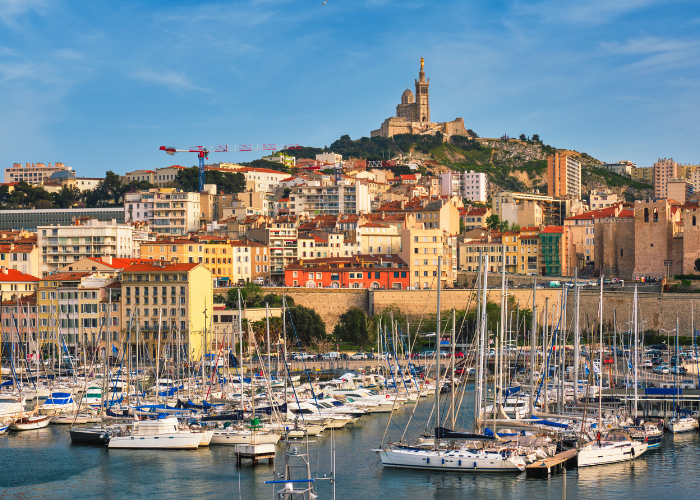If you look at Mediterranean homes, it’s easy to see why they’ve become popular among homeowners around the world. It’s incredibly simple, with a back-to-nature vibe that leans on natural materials and unassuming touches to create an inviting and relaxed feel.
Few architectural styles have stood the test of time the way Mediterranean-style architecture has.
Join Plus Render as we explore the fascinating world of Mediterranean-style architecture as well as how rendering and virtual reality (VR) help bring it to life.
What Is Mediterranean Architecture?
Mediterranean architecture, which was popularized in the 1920s, is timelessly beautiful and quintessential. It draws inspiration from the unique and traditional characteristics of many countries surrounding the Mediterranean Sea such as Italy, Portugal, and Spain.
Beyond harmonizing with its environment, it creates a seamless transition between its surroundings, the local culture, and natural materials, birthing a hyper-flexible style that leaves much room for personal expression. This makes it an attractive choice for anyone who enjoys a simple, leisurely lifestyle. While the design was initially used for opulent hotels and resort getaways, it now makes the perfect design and structural style for homes in warm-weather regions.
Types of Mediterranean-Style Homes
Here are the most common sub-styles of this architectural trend:
Spanish Revival:
The focus is on creating a clean, smooth, and uniform appearance, with the square footage dropping with every extra story built. It is characterized by low-pitch roofs, tower-like chimneys, and arcades that shelter walkways.
Italian Renaissance:
Inspired by Italy’s highly prosperous 16th century, this style is the most ornate of the lot. This is reflected in its European-style gardens, rounded arches, clayrooms, and two-story facades.
Modern Mediterranean:
Another informal name for minimalist Mediterranean architecture, it features open floor plans, decorative ironwork, white walls, and soft color schemes. If you don’t know how it compares to the age-old design it takes inspiration from, look at some adaptations that combine traditional Mediterranean with the modern world.
These are the major Mediterranean styles but there are countless variations in architecture.
Defining Characteristics of Mediterranean Architecture and How Rendering Brings Them to Life
Some features commonly seen in Mediterranean-style homes include:
Arches
The arch is a signature engineering marvel of Mediterranean architecture since Roman times. As homes in this style are airy and light, ornate arches can provide valuable support to the structure. They’re also used as decorative elements indoors in the form of arched windows, doors, and door frames.
You can keep the arches and archways as simple as you like or embellish them with patterned, handmade tiles or mosaic glass. To give your clients a peek into their aesthetic appeal, you can use 3D realistic renders to show them how arches can be used in various ways.
Stucco Walls
Mediterranean design is known for its stucco finishes, a cement-based plaster that hardens when it dries while creating an uneven texture. When applied on exterior walls, it reflects 80% to 100% sunlight, creating a powerful cooling effect in warm climates.
When used to spruce up interiors, it will reduce the amount of heat that escapes your space, which makes it ideal for maintaining comfortable indoor temperatures and lowering energy bills.
Your renderer can use texture mapping to model the final result. Since rendering enables flexibility and customizations, you can switch up the colors, lighting, and materials to simulate its finish, whether smooth, rough, or rustic.
Wrought Iron
Mediterranean-style architecture often uses wrought-iron accents. This iron alloy is soft, malleable, and incredibly durable. As it can be hammered and worked into different shapes, it can be used to produce gates and railings with intricate designs as well as lighting fixtures that create a warm and inviting ambiance. It can also be used as fencing to enclose your space.
To show how it elevates the architectural design with its elegance, use renders that highlight the wood-like grain caused by fibrous slag.
Red Clay Roof Tiles
Architecture for a Mediterranean-style home calls for using U-shaped red terracotta clay roof tiles instead of shingles. It adds a refined, old-world elegance to the property’s exterior while offering resilient roofing that can withstand the elements.
Red clay roof tiles offer the following benefits:
- The half-tube shape allows water to drain easily.
- This roof style captures cold air and reduces the amount of heat that enters the home.
Have your renderer reconstruct the tiled roof in different settings and seasons to showcase its timeless and versatile appeal.
Symmetrical Façades
The exteriors of Mediterranean-style buildings often have sprawling, symmetrical, ornate facades that are easy to identify even from a distance. A 3D rendering brings this visually striking aesthetic to life while allowing real estate professionals to commission different materials and textures with great accuracy.
Outdoor Living Spaces
Houses with Mediterranean-style architecture seamlessly blend indoor and outdoor living. Renders can add Mediterranean touches by adding outdoor elements like patios, courtyards, balconies, atriums, greenery, and water features like pools. Highlight extra large doors and windows to show how their sizes allow light and beautiful views from the outside to pour into the interiors.
An Earthy Color Scheme
Mediterranean-style architecture uses a color scheme that mimics the natural landscape. Think bright and striking hues like blue, green, orange, pink, and red. Consider adding neutrals or earthy tones like light brown, eggshell, clay, and tan.
Interiors can employ a white or earthy minimalist base complemented by more striking hues from the Mediterranean. Use artfully placed pops of color, like backsplashes, to give it an irresistible modern touch.
Create an Immersive Experience With Virtual Reality
The global 3D rendering market was worth $3.11 billion in 2022. It has a projected compound annual growth rate of 27.67% from 2023 to 2032. Because of these figures, we know that modern visualization technologies are the future of real estate. Anyone who wants to remain competitive must look for ways to leverage virtual environments.
One of rendering’s most popular applications is virtual reality. It merges the real world with the virtual, creating simulations that provide clients with immersive views of their Mediterranean-style homes. It makes them feel like they’re at the center of the property with the use of technical equipment and software. They can even interact with the life-like digital environment, engaging their senses and creating a deeper emotional connection with your design.
Having the ability to see what the property looks like with insane accuracy and attention to detail is invaluable. It can even be used to sell property before construction begins.
Advanced virtual reality systems may employ sensory feedback. For example, users can draw aside the curtains to gorgeous ocean views or simulate the sound of singing birds when they step “outside.” The use of this futuristic tech is guaranteed to make you stand out, help you attract the attention of your clients, and boost your credibility as a forward-thinking, cutting-edge professional.
Why Should Architects and Design Firms Use Virtual Reality and Renders?
Architects and design firms may be the best at creating Mediterranean-style architecture but to make their projects truly stand out, they need virtual reality and renders.
Here are a few of their advantages:
Better Marketing
3D rendering and VR are better marketing tools than 2D graphs and sketches. Research suggests that real estate websites with VR capabilities enjoy significantly higher views than those that only employ images. Moreover, they can be shared on social media platforms, embedded in websites, and shared in online ads.
Bigger Client Pool
Want to attract clients from beyond your immediate geographic region? Virtual reality and renders can be shared online, allowing you to capitalize on a worldwide market. If you want them to recognize you for your Mediterranean design skills, all you have to do is upload relevant projects on your website, social media accounts, and online directories.
Visualize Your Vision
Since 90% of the information transmitted to the brain is visual, using high-quality renders can help you communicate your design, its features, and design highlights. You don’t have to resort to technical descriptions and details. Your Mediterranean aesthetics can be understood more clearly, quickly, and easily with a quality render.
Avoid Design Flaws and Enhance Coordination
Virtual reality and renders offer you another tool with which you can avoid design flaws and enhance coordination. Instead of waiting until the design is built to notice inconsistencies and correct miscommunication with clients, you can address them early on without expensive do-overs.
Blueprint to Excellence: Partner With Plus Render on Your Mediterranean-Style Architecture
Are you a master of Mediterranean-style architecture but need help creating the perfect render, interactive virtual tour, or virtual reality experience? Plus Render, an architectural visualization studio, has the expertise and experience you need.
With our team of artists and technical experts, you can set yourself apart from the competition and establish yourself as the best Mediterranean-style architect in your field. We’ll take all your needs and all the intricacies of your designs into account so you end up with a render or virtual reality experience that you can be proud of.
Book a call to learn how our revolutionary team can help you create game-changing designs, excite buyers, and expand your reach.







